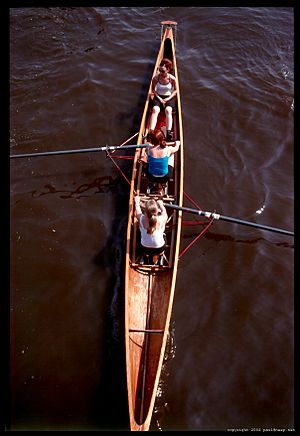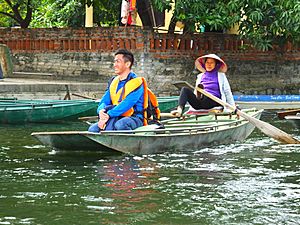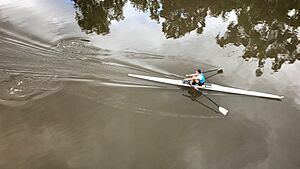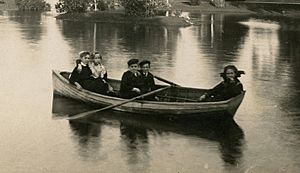Rowing facts for kids
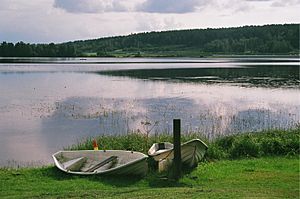
Rowing is how you move a boat using special poles called oars. You push the oars against the water to make the boat go forward. Rowing is a bit like paddling, but with rowing, the oars are attached to the boat. Paddles, however, are held in your hands and are not attached.
This article is about different ways people row boats for fun or for travel. It's not about the sport of competitive rowing, which has very strict rules and special boats.
Contents
History of Rowing
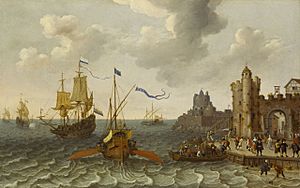
For thousands of years, people have used rowing to move boats. Ancient civilizations used rowing for travel, trading goods, and even for fighting wars. It helped them grow and explore.
Ancient Egypt
We don't know exactly when rowing started, but people in ancient Egypt used oars much like we do today. Archaeologists found a model of a rowing boat in an Egyptian tomb from about 1800-1900 BC.
From Egypt, rowing boats, especially large ships called galleys, became very important. They were used for naval battles and trade across the Mediterranean Sea. Galleys were good because they could move easily and quickly. They didn't need wind like sailing ships.
Ancient Greece
In ancient Greece, galleys were very powerful. The Athenians, a group of Greeks, had many galleys. They used thousands of their citizens as rowers in their navy.
A famous Greek warship called a trireme had 170 rowers! Later galleys had even more. Rowers used special cushions to slide on their seats. This let them use their strong leg muscles, just like modern rowers. Galleys usually had sails, but they would take them down before a fight. Sometimes, they even left their sails on shore to make the ship lighter.
Northern Europe
People in northern Europe started using oars for rowing later than in the Mediterranean. This happened between 500 BC and 1 AD. The Romans might have brought this idea when they conquered parts of Europe.
From about 500 to 1100 AD, during the Viking Age, boats that could both sail and row were very common. They were used for trade and war in northern Europe. Galleys continued to be used in the Mediterranean until steam-powered boats were invented.
How Rowing Systems Work
There are two main ways people row: facing backward or facing forward. In some places, like Venice, Italy, and in many parts of Asia, people often row facing forward. This is helpful in busy waterways. New rowing systems are also being invented, some very different from old ways.
Facing Backward
This is the oldest way of rowing in Europe and North America. A rower sits down and pulls on one or two oars. The oars push against the water, moving the boat. The point where the oar connects to the boat is called the oarlock. This is where the oar pivots.
On traditional boats, the oarlock is usually on the side of the boat, called the gunwale. It can be a simple peg or a metal fitting. On faster racing boats, the oarlock is often extended outwards on a frame called an outrigger. This allows for a longer oar, which gives more power.
When a rower uses two oars, one in each hand, it's called Sculling. The rower pulls the oars, and the boat moves in the opposite direction from where they are looking. In bigger boats, rowers might each use one large oar, called a "sweep", holding it with both hands.
Some boats have a special person called a coxswain who steers and tells the rowers what to do. These are called "coxed" boats. Many rowing boats use sliding seats. This lets the rower use their powerful leg muscles to push, which makes the boat go much faster. Another system, called a sliding rigger, keeps the seat still but moves the oarlocks with the rower's feet.
Facing Forward
Some oars are designed in two pieces and use a special system to reverse the oar's movement. This lets a seated rower face forward while still pulling the oars. An example is the RowVista system, which was patented in 2019. It uses a clever set of bars to make the oar blade move in the opposite direction of the handle.
Push rowing means using regular oars but pushing them instead of pulling. This makes the boat go forward while you face forward. It's useful for moving in tight spaces or busy harbors. The "Rantilla" system also lets you row forward with a pulling motion, but it uses oarlocks mounted inside the boat.
Another way to row forward is by using a single oar at the back of the boat, like the Chinese yuloh. You move it side to side in the water, like a fish's tail. This can move even very large boats.
In Ninh Bình Province in Vietnam, people row Sampan boats using their feet! The Intha people of Burma also row facing forward using their legs. The pletna boats in Slovenia are rowed forward by a standing person using two oars.
How Rowing Makes Boats Move
Rowing is a way to move a boat in a repeating cycle. To keep the boat moving at a steady speed, the forces pushing it forward must balance the forces slowing it down. The slowing forces come from air resistance above the water and water resistance below the water. The pushing forces come from the oars moving through the water.
You can think of an oar as a lever. The part of the oar in the water acts like a fixed point, or fulcrum. But the oar blade actually moves a little sideways and backward through the water. The power you get depends on how the water flows around the blade and how you apply force to the oar.
Rowing vs. Other Watercraft
What makes rowing different from canoeing or kayaking? In rowing, the oars are held in place at a fixed point on the boat. This point is where the oar pivots, acting like a second-class lever. The oar blade in the water is the fulcrum.
For fast rowing, boats (often called shells) are very narrow to reduce drag. The oars are attached to oarlocks (also called gates) at the end of outriggers that stick out from the sides of the boat. Racing boats also have sliding seats so rowers can use their legs for more power.
Venetian Rowing
In Venice, Italy, boats like gondolas are very popular. They are moved by oars held in special wooden supports called fórcola. The Voga alla Veneta rowing style is different from international sport rowing. The rower stands and faces forward. This allows the boat to turn very quickly and easily, which is perfect for Venice's narrow and busy canals. There are even races using this Venetian rowing style.
There are three main ways to row in Venice:
- One rower with one oar, standing at the back. The oar also helps steer.
- One or two rowers, each with two crossed oars (called a la valesàna).
- Two or more rowers, taking turns rowing on different sides of the boat.
Boat Design
The classic shapes of rowboats have changed over hundreds of years. Designers try to find the best shape for different uses. They think about things like how long the boat is, how fast it can go, how much it can carry, and how stable it is.
Width and Height
If a boat is too narrow, it might tip over easily. If it's too wide, it will be slow and hard to row. The distance between the oarlocks is also important. If they are too close, the oars are hard to use. If they are too far apart, it's hard to row efficiently. Sometimes, narrow boats have outriggers to make the oarlocks wider apart.
The height of the boat's side above the water (called freeboard) is also key. If it's too high, the wind will push the boat around. If it's too low, waves might come into the boat.
Length
The length of a rowing boat affects its speed. If a boat is too short, it won't go very fast. If it's too long, it will have more friction with the water and be slower.
A good length for a general rowing boat is around 16 feet (about 5 meters). Longer boats are often narrower and faster, but they can be harder to balance.
Weight
The weight of a rowboat has pros and cons. A very light boat might slow down quickly after each oar stroke. A heavier boat will keep moving forward more smoothly.
Most modern rowboats are much lighter than older, traditional ones.
Performance
The curve of the boat's bottom, called rocker, affects how it performs. Longer, thinner racing boats have less rocker, about 3 inches (7.6 cm). A short, 8-foot (2.4 m) dinghy might have 6-7 inches (15-18 cm) of rocker.
Boats with less rocker are faster and easier to row in calm water. But in waves, a boat with more rocker (5-6 inches or 12-15 cm) will ride over the waves better. Boats with more rocker can also turn more easily.
Some boats, like dories, have high sides and narrow ends. The wind can push them around. Rowers can use a container of water on a rope to change the boat's balance if needed.
Long-distance rowers can keep a steady pace of about 20 strokes per minute. Racing athletes can row much faster, 30-40 strokes per minute, but only for short periods. Most 14-foot (4.2 m) rowboats can go about 3-4 knots (5.5-7.4 km/h).
Oars
Over time, the design of oars and their blades has changed a lot. The part of the oar inside the boat usually stays the same length. But the part outside the boat, which goes in the water, has become shorter. Different oar lengths affect how much energy the rower needs and how fast the boat goes.
A short oar allows for quick, short strokes. This is good in narrow waterways or crowded areas. It's also helpful in a small boat that might be carrying a lot of people. Short strokes can prevent the front of the boat from diving into choppy waves when it's heavy.
Longer oars allow for longer, slower strokes. These are easier to keep up over long distances. Oars are usually made from light, strong wood like fir or ash. The blades can be flat for general use or spoon-shaped for more speed.
Whitehall Rowboats
The Whitehall rowboat is a special and useful type of boat. No one is quite sure where it came from. Some people think it came from England. However, a famous boat historian named Howard I. Chapelle believed it was first built in New York City in the 1820s. He thought navy workers created the design, possibly inspired by old naval boats.
See also
 In Spanish: Bogar para niños
In Spanish: Bogar para niños
Images for kids



